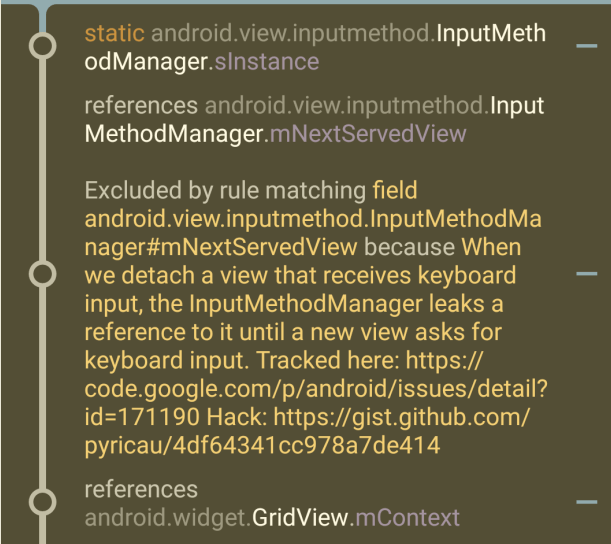轉(zhuǎn)載來之
http://blog.nimbledroid.com/2016/05/23/memory-leaks-zh.html
像 Java 這樣具有垃圾回收功能的語言的好處之一灭翔,就是程序員無需手動管理內(nèi)存分配涣雕。這減少了段錯誤(segmentation fault)導(dǎo)致的閃退简僧,也減少了內(nèi)存泄漏導(dǎo)致的堆空間膨脹,讓編寫的代碼更加安全。然而,Java 中依然有可能發(fā)生內(nèi)存泄漏。所以你的安卓 APP 依然有可能浪費了大量的內(nèi)存敛纲,甚至由于內(nèi)存耗盡(OOM)導(dǎo)致閃退。
傳統(tǒng)的內(nèi)存泄漏是由忘記釋放分配的內(nèi)存導(dǎo)致的剂癌,而邏輯上的內(nèi)存泄漏則是由于忘記在對象不再被使用的時候釋放對其的引用導(dǎo)致的淤翔。如果一個對象仍然存在強引用,垃圾回收器就無法對其進(jìn)行垃圾回收佩谷。在安卓平臺旁壮,泄漏 Context 對象問題尤其嚴(yán)重辞做。這是因為像 Activity 這樣的 Context 對象會引用大量很占用內(nèi)存的對象,例如 View 層級寡具,以及其他的資源秤茅。如果 Context 對象發(fā)生了內(nèi)存泄漏,那它引用的所有對象都被泄漏了童叠。安卓設(shè)備大多內(nèi)存有限框喳,如果發(fā)生了大量這樣的內(nèi)存泄漏,那內(nèi)存將很快耗盡厦坛。
如果一個對象的合理生命周期沒有清晰的定義五垮,那判斷邏輯上的內(nèi)存泄漏將是一個見仁見智的問題。幸運的是杜秸,activity 有清晰的生命周期定義放仗,使得我們可以很明確地判斷 activity 對象是否被內(nèi)存泄漏。onDestroy() 函數(shù)將在 activity 被銷毀時調(diào)用撬碟,無論是程序員主動銷毀 activity诞挨,還是系統(tǒng)為了回收內(nèi)存而將其銷毀。如果 onDestroy 執(zhí)行完畢之后呢蛤,activity 對象仍被 heap root 強引用惶傻,那垃圾回收器就無法將其回收。所以我們可以把生命周期結(jié)束之后仍被引用的 activity 定義為被泄漏的 activity其障。
Activity 是非常重量級的對象银室,所以我們應(yīng)該極力避免妨礙系統(tǒng)對其進(jìn)行回收。然而有多種方式會讓我們無意間就泄露了 activity 對象励翼。我們把可能導(dǎo)致 activity 泄漏的情況分為兩類蜈敢,一類是使用了進(jìn)程全局(process-global)的靜態(tài)變量,無論 APP 處于什么狀態(tài)汽抚,都會一直存在抓狭,它們持有了對 activity 的強引用進(jìn)而導(dǎo)致內(nèi)存泄漏,另一類是生命周期長于 activity 的線程殊橙,它們忘記釋放對 activity 的強引用進(jìn)而導(dǎo)致內(nèi)存泄漏辐宾。下面我們就來詳細(xì)分析一下這些可能導(dǎo)致 activity 泄漏的情況狱从。
- 靜態(tài) Activity
泄漏 activity 最簡單的方法就是在 activity 類中定義一個 static 變量膨蛮,并且將其指向一個運行中的 activity 實例。如果在 activity 的生命周期結(jié)束之前季研,沒有清除這個引用敞葛,那它就會泄漏了。這是因為 activity(例如 MainActivity) 的類對象是靜態(tài)的与涡,一旦加載惹谐,就會在 APP 運行時一直常駐內(nèi)存持偏,因此如果類對象不卸載,其靜態(tài)成員就不會被垃圾回收氨肌。
void setStaticActivity() { activity = this;}View saButton = findViewById(R.id.sa_button);saButton.setOnClickListener(new View.OnClickListener() { @Override public void onClick(View v) { setStaticActivity(); nextActivity(); }});

內(nèi)存泄漏場景 1 - Static Activity
- 靜態(tài) View
另一種類似的情況是對經(jīng)常啟動的 activity 實現(xiàn)一個單例模式鸿秆,讓其常駐內(nèi)存可以使它能夠快速恢復(fù)狀態(tài)。然而怎囚,就像前文所述卿叽,不遵循系統(tǒng)定義的 activity 生命周期是非常危險的,也是沒必要的恳守,所以我們應(yīng)該極力避免考婴。
但是如果我們有一個創(chuàng)建起來非常耗時的 View,在同一個 activity 不同的生命周期中都保持不變呢催烘?所以讓我們?yōu)樗鼘崿F(xiàn)一個單例模式沥阱,就像這段代碼。現(xiàn)在一旦 activity 被銷毀伊群,那我們就應(yīng)該釋放大部分的內(nèi)存了考杉。
void setStaticView() { view = findViewById(R.id.sv_button);}View svButton = findViewById(R.id.sv_button);svButton.setOnClickListener(new View.OnClickListener() { @Override public void onClick(View v) { setStaticView(); nextActivity(); }});

內(nèi)存泄漏場景 2 - Static View
內(nèi)存泄漏了!因為一旦 view 被加入到界面中舰始,它就會持有 context 的強引用奔则,也就是我們的 activity。由于我們通過一個靜態(tài)成員引用了這個 view蔽午,所以我們也就引用了 activity易茬,因此 activity 就發(fā)生了泄漏。所以一定不要把加載的 view 賦值給靜態(tài)變量及老,如果你真的需要抽莱,那一定要確保在 activity 銷毀之前將其從 view 層級中移除。
- 內(nèi)部類
現(xiàn)在讓我們在 activity 內(nèi)部定義一個類骄恶,也就是內(nèi)部類食铐。這樣做的原因有很多,比如增加封裝性和可讀性僧鲁。如果我們創(chuàng)建了一個內(nèi)部類的對象虐呻,并且通過靜態(tài)變量持有了 activity 的引用,那也會發(fā)生 activity 泄漏寞秃。
void createInnerClass() { class InnerClass { } inner = new InnerClass();}View icButton = findViewById(R.id.ic_button);icButton.setOnClickListener(new View.OnClickListener() { @Override public void onClick(View v) { createInnerClass(); nextActivity(); }});

內(nèi)存泄漏場景 3 - Inner Class
不幸的是斟叼,內(nèi)部類能夠引用外部類的成員這一優(yōu)勢,就是通過持有外部類的引用來實現(xiàn)的春寿,而這正是 activity 泄漏的原因朗涩。
- 匿名類
類似的,匿名類同樣會持有定義它們的對象的引用绑改。因此如果在 activity 內(nèi)定義了一個匿名的 AsyncTask 對象谢床,就有可能發(fā)生內(nèi)存泄漏了兄一。如果 activity 被銷毀之后 AsyncTask 仍然在執(zhí)行,那就會組織垃圾回收器回收 activity 對象识腿,進(jìn)而導(dǎo)致內(nèi)存泄漏出革,直到執(zhí)行結(jié)束才能回收 activity。
void startAsyncTask() { new AsyncTask<Void, Void, Void>() { @Override protected Void doInBackground(Void... params) { while(true); } }.execute();}super.onCreate(savedInstanceState);setContentView(R.layout.activity_main);View aicButton = findViewById(R.id.at_button);aicButton.setOnClickListener(new View.OnClickListener() { @Override public void onClick(View v) { startAsyncTask(); nextActivity(); }});
內(nèi)存內(nèi)存泄漏場景 4 - AsyncTask
- Handlers
同樣的渡讼,定義一個匿名的 Runnable 對象并將其提交到 Handler 上也可能導(dǎo)致 activity 泄漏蹋盆。Runnable 對象間接地引用了定義它的 activity 對象,而它會被提交到 Handler 的 MessageQueue 中硝全,如果它在 activity 銷毀時還沒有被處理栖雾,那就會導(dǎo)致 activity 泄漏了。
void createHandler() { new Handler() { @Override public void handleMessage(Message message) { super.handleMessage(message); } }.postDelayed(new Runnable() { @Override public void run() { while(true); } }, Long.MAX_VALUE >> 1);}View hButton = findViewById(R.id.h_button);hButton.setOnClickListener(new View.OnClickListener() { @Override public void onClick(View v) { createHandler(); nextActivity(); }});

內(nèi)存泄漏場景 5 - Handler
- Threads
同樣的伟众,使用 Thread 和 TimerTask 也可能導(dǎo)致 activity 泄漏析藕。
void spawnThread() { new Thread() { @Override public void run() { while(true); } }.start();}View tButton = findViewById(R.id.t_button);tButton.setOnClickListener(new View.OnClickListener() { @Override public void onClick(View v) { spawnThread(); nextActivity(); }});

內(nèi)存泄漏場景 6 - Thread
- Timer Tasks
只要它們是通過匿名類創(chuàng)建的,盡管它們在單獨的線程被執(zhí)行凳厢,它們也會持有對 activity 的強引用账胧,進(jìn)而導(dǎo)致內(nèi)存泄漏。
void scheduleTimer() { new Timer().schedule(new TimerTask() { @Override public void run() { while(true); } }, Long.MAX_VALUE >> 1);}View ttButton = findViewById(R.id.tt_button);ttButton.setOnClickListener(new View.OnClickListener() { @Override public void onClick(View v) { scheduleTimer(); nextActivity(); }});
內(nèi)存泄漏場景 7 - TimerTask
- Sensor Manager
最后先紫,系統(tǒng)服務(wù)可以通過 context.getSystemService 獲取治泥,它們負(fù)責(zé)執(zhí)行某些后臺任務(wù),或者為硬件訪問提供接口遮精。如果 context 對象想要在服務(wù)內(nèi)部的事件發(fā)生時被通知居夹,那就需要把自己注冊到服務(wù)的監(jiān)聽器中。然而本冲,這會讓服務(wù)持有 activity 的引用准脂,如果程序員忘記在 activity 銷毀時取消注冊,那就會導(dǎo)致 activity 泄漏了檬洞。
void registerListener() { SensorManager sensorManager = (SensorManager) getSystemService(SENSOR_SERVICE); Sensor sensor = sensorManager.getDefaultSensor(Sensor.TYPE_ALL); sensorManager.registerListener(this, sensor, SensorManager.SENSOR_DELAY_FASTEST);}View smButton = findViewById(R.id.sm_button);smButton.setOnClickListener(new View.OnClickListener() { @Override public void onClick(View v) { registerListener(); nextActivity(); }});

內(nèi)存泄漏場景 8 - Sensor Manager
現(xiàn)在狸膏,我們展示了八種很容易不經(jīng)意間就泄漏大量內(nèi)存的情景。請記住添怔,最壞的情況下湾戳,你的 APP 可能會由于大量的內(nèi)存泄漏而內(nèi)存耗盡,進(jìn)而閃退广料,但它并不總是這樣砾脑。相反,內(nèi)存泄漏會消耗大量的內(nèi)存性昭,但卻不至于內(nèi)存耗盡拦止,這時县遣,APP 會由于內(nèi)存不夠分配而頻繁進(jìn)行垃圾回收糜颠。垃圾回收是非常耗時的操作汹族,會導(dǎo)致嚴(yán)重的卡頓。在 activity 內(nèi)部創(chuàng)建對象時其兴,一定要格外小心顶瞒,并且要經(jīng)常測試是否存在內(nèi)存泄漏。
SDK內(nèi)存泄漏 :
今天在使用LeakCanary檢查應(yīng)用的內(nèi)存泄露時元旬,報了一個這樣的錯誤榴徐,并且還給出了參考鏈接,原來這是Android輸入法的一個bug匀归,在15<=API<=23中都存在坑资。

?LeakCanary之所以能夠顯示參考鏈接是因為它有一個針對SDK已知內(nèi)存泄露的列表,放在AndroidExcludedRefs.java中穆端,比如輸入法的這個袱贮。
[圖片上傳中。体啰。攒巍。(2)]
?這個問題很多人都遇到過,網(wǎng)上已經(jīng)有比較成熟的方案荒勇,分析原因比較透徹的是這篇文章:[Android][Memory Leak] InputMethodManager內(nèi)存泄露現(xiàn)象及解決柒莉,改善方案可以參考Leaknary給出的方案:InputMethodManager內(nèi)存泄露修正方案,在退出使用InputMethodManager的Activity時沽翔,調(diào)用fixFocusedViewLeak方法即可解決兢孝。
/** * Fix for https://code.google.com/p/android/issues/detail?id=171190 . * * When a view that has focus gets detached, we wait for the main thread to be idle and then * check if the InputMethodManager is leaking a view. If yes, we tell it that the decor view got * focus, which is what happens if you press home and come back from recent apps. This replaces * the reference to the detached view with a reference to the decor view. * * Should be called from {@link Activity#onCreate(android.os.Bundle)} )}. */public static void fixFocusedViewLeak(Application application) { // Don't know about other versions yet. if (Build.VERSION.SDK_INT < Build.VERSION_CODES.ICE_CREAM_SANDWICH_MR1|| Build.VERSION.SDK_INT > 23) { return; } final InputMethodManager inputMethodManager = (InputMethodManager) application.getSystemService(Context.INPUT_METHOD_SERVICE); final Field mServedViewField; final Field mHField; final Method finishInputLockedMethod; final Method focusInMethod; try { mServedViewField = InputMethodManager.class.getDeclaredField("mServedView"); mServedViewField.setAccessible(true); mHField = InputMethodManager.class.getDeclaredField("mServedView"); mHField.setAccessible(true); finishInputLockedMethod = InputMethodManager.class.getDeclaredMethod("finishInputLocked"); finishInputLockedMethod.setAccessible(true); focusInMethod = InputMethodManager.class.getDeclaredMethod("focusIn", View.class); focusInMethod.setAccessible(true); } catch (NoSuchMethodException | NoSuchFieldException unexpected) { Log.e("IMMLeaks", "Unexpected reflection exception", unexpected); return; } application.registerActivityLifecycleCallbacks(new Application.ActivityLifecycleCallbacks() { @Override public void onActivityDestroyed(Activity activity){ } @Override public void onActivityStarted(Activity activity){ } @Override public void onActivityResumed(Activity activity){ } @Override public void onActivityPaused(Activity activity){ } @Override public void onActivityStopped(Activity activity){ } @Override public void onActivitySaveInstanceState(Activity activity, Bundle bundle){ } @Override public void onActivityCreated(Activity activity, Bundle savedInstanceState) { ReferenceCleaner cleaner = new ReferenceCleaner(inputMethodManager, mHField, mServedViewField, finishInputLockedMethod); View rootView = activity.getWindow().getDecorView().getRootView(); ViewTreeObserver viewTreeObserver = rootView.getViewTreeObserver(); viewTreeObserver.addOnGlobalFocusChangeListener(cleaner); } });}static class ReferenceCleaner implements MessageQueue.IdleHandler, View.OnAttachStateChangeListener, ViewTreeObserver.OnGlobalFocusChangeListener { private final InputMethodManager inputMethodManager; private final Field mHField; private final Field mServedViewField; private final Method finishInputLockedMethod; ReferenceCleaner(InputMethodManager inputMethodManager, Field mHField, Field mServedViewField, Method finishInputLockedMethod) { this.inputMethodManager = inputMethodManager; this.mHField = mHField; this.mServedViewField = mServedViewField; this.finishInputLockedMethod = finishInputLockedMethod; } @Override public void onGlobalFocusChanged(View oldFocus, View newFocus) { if (newFocus == null) { return; } if (oldFocus != null) { oldFocus.removeOnAttachStateChangeListener(this); } Looper.myQueue().removeIdleHandler(this); newFocus.addOnAttachStateChangeListener(this); } @Override public void onViewAttachedToWindow(View v) { } @Override public void onViewDetachedFromWindow(View v) { v.removeOnAttachStateChangeListener(this); Looper.myQueue().removeIdleHandler(this); Looper.myQueue().addIdleHandler(this); } @Override public boolean queueIdle() { clearInputMethodManagerLeak(); return false; } private void clearInputMethodManagerLeak() { try { Object lock = mHField.get(inputMethodManager); // This is highly dependent on the InputMethodManager implementation. synchronized (lock) { View servedView = (View) mServedViewField.get(inputMethodManager); if (servedView != null) { boolean servedViewAttached = servedView.getWindowVisibility() != View.GONE; if (servedViewAttached) { // The view held by the IMM was replaced without a global focus change. Let's make // sure we get notified when that view detaches. // Avoid double registration. servedView.removeOnAttachStateChangeListener(this); servedView.addOnAttachStateChangeListener(this); } else { // servedView is not attached. InputMethodManager is being stupid! Activity activity = extractActivity(servedView.getContext()); if (activity == null || activity.getWindow() == null) { // Unlikely case. Let's finish the input anyways. finishInputLockedMethod.invoke(inputMethodManager); } else { View decorView = activity.getWindow().peekDecorView(); boolean windowAttached = decorView.getWindowVisibility() != View.GONE; if (!windowAttached) { finishInputLockedMethod.invoke(inputMethodManager); } else { decorView.requestFocusFromTouch(); } } } } } } catch (IllegalAccessException |InvocationTargetException unexpected) { Log.e("IMMLeaks", "Unexpected reflection exception", unexpected); } } private Activity extractActivity(Context context) { while (true) { if (context instanceof Application) { return null; } else if (context instanceof Activity) { return (Activity) context; } else if (context instanceof ContextWrapper) { Context baseContext = ((ContextWrapper) context).getBaseContext(); // Prevent Stack Overflow. if (baseContext == context) { return null; } context = baseContext; } else { return null; } } }}